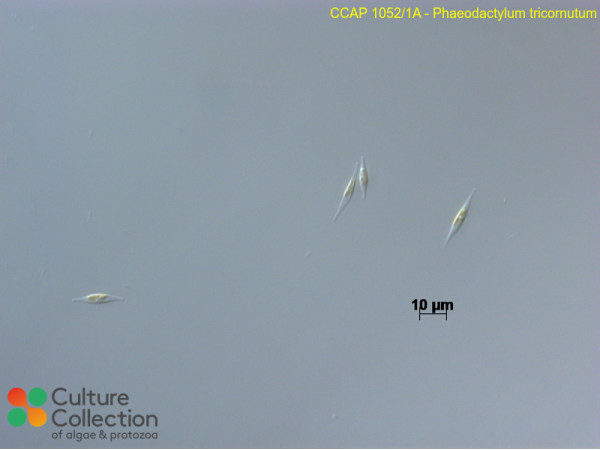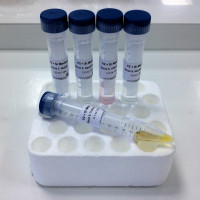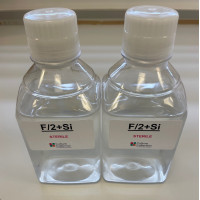References [ 46 ]
Loreti V, Toncelli D, Morelli E, Scarano G & Bettner J (2005) Biosynthesis of Cd-bound phytochelatins by Phaeodactylum tricornutum and their speciation by size-exclusion chromatography and ion-pair chromatography coupled to ICP-MS. Analytical and Bioanalytical Chemistry 383: 398-403.
Scarano G & Morelli E (2002) Characterisation of cadmium- and lead-phytochelatin complexes formed in a marine microalga in response to metal exposure. Biometals 15: 145-151.
Morelli E, Mascherpa MC & Scarano G (2005) Biosynthesis of phytochelatins and arsenic accumulation in the marine microalgae Phaeodactylum tricornutum in response to arsenate exposure. Biometals 18(6): 587-593.
Taylor RL, Caldwell GS, Dunstan HJ & Bentley MG (2007) Short-term impacts of polyunsaturated aldehyde-producing diatoms on the harpacticoid copepod, Tisbe holothuriae. Journal of Experimental Marine Biology and Ecology 341: 60-69.
Morelli E & Scarano G (2001) Synthesis and stability of phytochelatins induced by cadmium and lead in the marine diatom Phaeodactylum tricornutum. Marine Environmental Research 52: 383-395.
Morelli E, Cruz BH, Somovigo S & Scarano G (2002) Speciation of cadmium-glutamyl peptides complexes in cells of the marine microalga Phaeodactylum tricornutum. Plant Science 163: 807-813.
Morelli E & Scarano G (2004) Copper-induced changes of non-protein thiols and antioxidant enzymes in the marine microalga Phaeodactylum tricornutum. Plant Science 167: 289-296.
Scarano G & Morelli E (2003) Properties of phytochelatin-coated CdS nanochrystallites formed in a marine phytoplanktonic alga (Phaeodactylum tricornutum, Bohlin) in response to Cd. Plant Science 165: 803-810.
Burkhardt E, Amoroso G, Riebesell U & Sültemeyer D (2001) CO2 and HCO3- uptake in marine diatoms acclimated to different CO2 concentrations. Limnology and Oceanography 46(6): 1378-1391.
DOI: none
Evangelista V, Frassanito AM, Passarelli V, Barsanti L & Gualtieri P (2006) Microspectroscopy of the photosynthetic compartment of algae. Photochemistry and Photobiology 82(4): 1039-1046.
Johnston AM (1996) The effect of environmental variables on 13C discrimination by two marine phytoplankton. Marine Ecology - Progress Series 132: 257-263.
Morelli E & Fantozzi L (2008) Phytochelatins in the diatom Phaeodactylum tricornutum (Bohlin): An evaluation of their use as biomarkers of metal exposure in marine waters. Bulletin of Environmental Contamination and Toxicology 81(3): 236-241.
Riebesell U, Burkhardt S, Dauelsberg A & Kroon B (2000) Carbon isotope fractionation by a marine diatom: Dependence on the growth-rate-limiting resource. Marine Ecology - Progress Series 193: 295-303.
Love GD, Bowden SA, Summons RE, Jahnke LL, Snape CE, Campbell CN & Day JG (2005) An optimised catalytic hydropyrolysis method for the rapid screening of microbial cultures for lipid biomarkers. Organic Geochemistry 36: 63-83.
Day JG, Benson EE & Fleck RA (1999) In Vitro Culture and Conservation Of Microalgae: Applications For Environmental Research, Aquaculture & Biotechnology. In Vitro Cellular & Developmental Biology - Plant 35: 127-136.
Eddy BP (1956) The suitability of some algae for mass cultivation for food, with special reference to Dunaliella bioculata. Journal of Experimental Botany 21: 372-380.
De Martino A, Meichenin A, Shi J, Pan K & Bowler C (2007) Genetic and phenotypic characterization of Phaeodactylum tricornutum (Bacillariophyceae) accessions. Journal of Phycology 43: 992-1009.
Domenighini A & Giordano M (2009) Fourier transform infrared spectroscopy of microalgae as a novel tool for biodiversity studies, species identification, and the assessment of water quality. Journal of Phycology 45: 522-531.
Moniz MBJ & Kaczmarska I (2010) Barcoding of diatoms: Nuclear encoded ITS revisited. Protist 161: 7-34.
Morelli E, Marangi ML & Fantozzi L (2009) A phytochelatin-based bioassay in marine diatoms useful for the assessment of bioavailability of heavy metals released by polluted sediments. Environmental International 35: 532-538.
Cassar N, Laws EA & Popp BN (2006) Carbon isotopic fractionation by the marine diatom Phaeodactylum tricornutum under nutrient- and light-limited growth conditions. Geochimica et Cosmochimica Acta 70: 5323-5335.
Hatton AD & Wilson ST (2007) Particulate dimethylsulphoxide and dimethylsulphoniopropionate in phytoplankton cultures and Scottish coastal waters. Aquatic Sciences - Research Across Boundaries 69: 330-340.
Erga SR, Lie GC, Aarø LH, Aursland K, Olseng CD, Frette Ø & Hamre B (2010) Fine scale vertical displacement of Phaeodactylum tricornutum (Bacillariophyceae) in stratified waters: Influence of halocline and day length on buoyancy control. Journal of Experimental Marine Biology and Ecology 384: 7-17.
Chen X, Qiu CE & Shao JZ (2006) Evidence for K+-dependent HCO3- utilization in the marine diatom phaeodactylum tricornutum. Plant Physiology 141: 731-736.
DOI: none
De Martino A, Bartual A, Willis A, Meichenin A, Villazán B, Maheswari U & Bowler C (2011) Physiological and molecular evidence that environmental changes elicit morphological interconversion in the model diatom Phaeodactylum tricornutum. Protist 162: 462-481.
Taylor RL, Caldwell GS, Olive PJW & Bentley MG (2012) The harpacticoid copepod Tisbe holothuriae is resistant to the insidious effects of polyunsaturated aldehyde-producing diatoms. Journal of Experimental Marine Biology and Ecology 413: 30-37.
Pavlic Z, Vidakovic-Cifrek Z & Puntaric D (2005) Toxicity of surfactants to green microalgae Pseudokirchneriella subcapitata and Scenedesmus subspicatus and to marine diatoms Phaeodactylum tricornutum and Skeletonema costatum. Chemosphere 61: 1061-1068.
Wilson ST (2007) The production of biogenic gases in the marine environment. A Thesis presented for the degree of Doctor of Philosophy at the Open University -: 319 pp.
DOI: none
Giordano M, Ratti S, Domenighini A & Vogt F (2009) Spectroscopic classification of 14 different microalga species: first steps towards spectroscopic measurement of phytoplankton biodiversity Plant Ecology & Diversity 2: 155-164.
Watson GJ, Bentley MG, Gaudron SM & Hardege JD (2003) The role of chemical signals in the spawning induction of polychaete worms and other marine invertebrates. Journal of Experimental Marine Biology and Ecology 294: 169-187.
John-McKay ME & Colman B (1997) Variation in the occurrence of external carbonic anhydrase among strains of the marine diatom Phaeodactylum tricornutum (Bacillariophyceae). Journal of Phycology 33: 988-990.
DOI: none
Palmucci M, Ratti S & Giordano M (2011) Ecological and evolutionary implications of carbon allocation in marine phytoplankton as a function of nitrogen availability: A Fourier transform infrared spectroscopy approach. Journal of Phycology 47: 313-323.
Aravantinou AF, Theodorakopoulos MA & Manariotis ID (2013) Selection of microalgae for wastewater treatment and potential lipids production. Bioresource Technology 147: 130-134.
Carteau D, Vallee-Rehel K, Linossier I, Quiniou F, Davy R, Compere C, Delbury M & Fay F (2014) Development of environmentally friendly antifouling paints using biodegradable polymer and lower toxic substances. Progress in Organic Coatings 77: 485-493.
McLellan MR (1989) Cryopreservation of diatoms. Diatom Research 4: 301-318.
He L, Han X & Yu Z (2014) A rare Phaeodactylum tricornutum cruciform morphotype: Culture conditions, transformation and unique fatty acid characteristics. PLoS ONE 9: e93922.
Prestegard SK, Knutsen G & Herfindal L (2014) Adenosine content and growth in the diatom Phaeodactylum tricornutum (Bacillariophyceae): Effect of salinity, light, temperature and nitrate. Diatom Research 29: 361-369.
Claessens M, Monteyne E, Wille K, Vanhaecke L, Roose P & Janssen CR (2015) Passive sampling reversed: Coupling passive field sampling with passive lab dosing to assess the ecotoxicity of mixtures present in the marine environment. Marine Pollution Bulletin 93: 9-19.
Stanley MS & Callow JA (2007) Whole cell adhesion strength of morphotypes and isolates of Phaeodactylum tricornutum (Bacillariophyceae). European Journal of Phycology 42: 191-197.
Zhou C, Vitiello V, Pellegrini D, Wu C, Morelli E & Buttino I (2016) Toxicological effects of CdSe/ZnS quantum dots on marine planktonic organisms. Ecotoxicology and Environmental Safety 123: 26-31.
Lis H, Shaked Y, Kranzler C, Keren N & Morel FMM (2015) Iron bioavailability to phytoplankton: An empirical approach. The ISME Journal 9: 1003-1013.
Giovagnetti V & Ruban AV (2017) Detachment of the fucoxanthin chlorophyll a/c binding protein (FCP) antenna is not involved in the acclimative regulation of photoprotection in the pennate diatom Phaeodactylum tricornutum Bioenergetics 1858: 218-230.
Avilan L, Puppo C, Villain A, Bouveret E, Menand B, Field B & Gontero B (2019) RSH enzyme diversity for (p)ppGpp metabolism in Phaeodactylum tricornutum and other diatoms Scientific Reports 9: 17682.
Herbert H, Parkes R, Barone ME, McDonnell A, Picciotto S, Adamo G, Paterna A, Manno M, Bongiovanni A, Touzet N & Campion E (2024) Antioxidant properties and bioactivity of three marine microalgae on human cancer cell lines Applied Phycology -: 1-17.
Liu C, Li L, Yang S, Wang M, Zhang H & Li S (2024) Multi-omic insights into the cellular response of Phaeodactylum tricornutum (Bacillariophyta) strains under grazing pressure. Frontiers in Plant Science 14: 1308085.
Zhang J, Li C, Xiong X, Guo K, Feng Y, Jiang Y, Zhang H, Hu H & Li X (2024) A removable and cosmopolitan dsRNA Toti-like virus causes asymptomatic but productive infection in a model diatom strain Algal Research 79: 103491.




